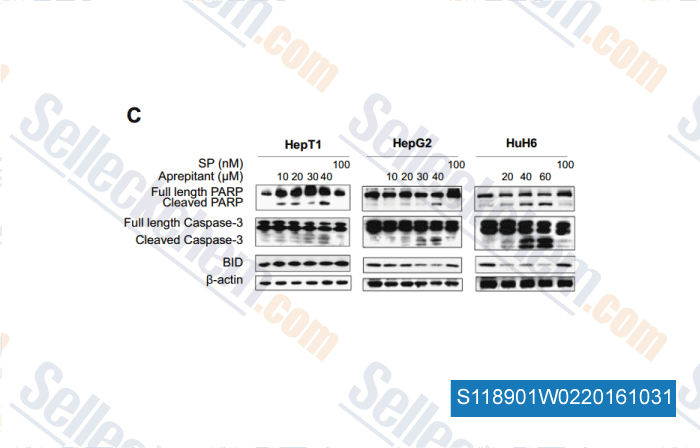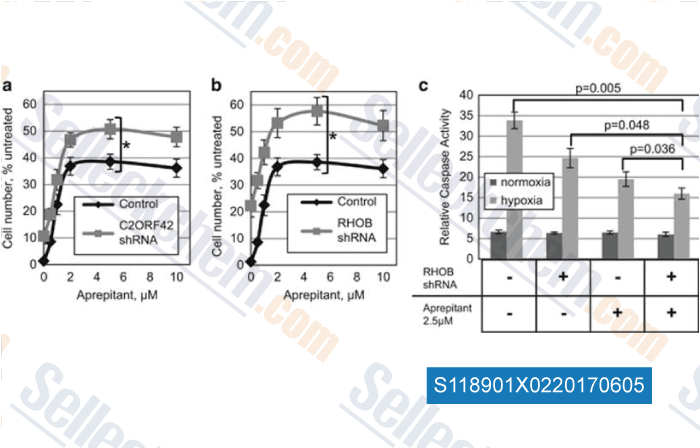|
Toll Free: (877) 796-6397 -- USA and Canada only -- |
Fax: +1-832-582-8590 Orders: +1-832-582-8158 |
Tech Support: +1-832-582-8158 Ext:3 Please provide your Order Number in the email. |
Technical Data
| Formula | C23H21F7N4O3 |
|||
| Molecular Weight | 534.43 | CAS No. | 170729-80-3 | |
| Solubility (25°C)* | In vitro | DMSO | 107 mg/mL (200.21 mM) | |
| Ethanol | 25 mg/mL (46.77 mM) | |||
| Water | Insoluble | |||
|
* <1 mg/ml means slightly soluble or insoluble. * Please note that Selleck tests the solubility of all compounds in-house, and the actual solubility may differ slightly from published values. This is normal and is due to slight batch-to-batch variations. * Room temperature shipping (Stability testing shows this product can be shipped without any cooling measures.) |
||||
Preparing Stock Solutions
Biological Activity
| Description | Aprepitant is a potent and selective neurokinin-1 receptor antagonist with IC50 of 0.1 nM. Aprepitant reduces levels of pro-inflammatory cytokines including G-CSF, IL-6, IL-8 and TNFα. Aprepitant inhibits HIV infection of human macrophages. | ||||||||||
|---|---|---|---|---|---|---|---|---|---|---|---|
| Targets |
|
||||||||||
| In vitro | Aprepitant antagonizes the effects of substance P by binding to NK-1 receptors primarily in the CNS, but also in the periphery. Aprepitant, at concentrations of 0.1 nM displaces 50% of substance P from hNK1 receptors transfected in CHO or COS cells. In radioligand binding assays, Aprepitant is 3000-fold selective for the human cloned NK1 receptor versus the human cloned NK3 receptor and >50,000-fold selective over the human cloned NK2 receptor. In a range of assays at other human cloned G–protein coupled receptors, Aprepitant retains >50,000-fold selectivity for the human cloned NK1 receptor. Aprepitant is inactive in human monoamine oxidase A and B assays and at human serotonin 5–HT1A, 5–HT2A, 5–HT2c, 5–HT3, 5–HT5, 5–HT6, and 5–HT7 receptors (IC50>3 μM). In the PANLABS panel of radioligand binding screens using native animal tissues, Aprepitant inhibits [3H]substance P binding to native NK1 receptors in rat submaxillary gland; there are no significant interactions of Aprepitant with any other native animal G–protein coupled receptors or ion channels examined in the PANLABS screen. Aprepitant is inactive in monoamine uptake site (NE, 5–HT, DA) counterscreens using human and animal tissues (IC50> 3 μM) [1] |
||||||||||
| In vivo | Aprepitant crosses the blood–brain barrier and occupied NK-1 receptors in the brain. Aprepitant has been shown to inhibit both acute and delayed emesis induced by cytotoxic chemotherapeutic such as cisplatin by blocking substance P. Aprepitant (3 mg/kg i.v. or p.o.) inhibits the emetic response to cisplatin (10 mg/kg i.v.). The anti-emetic protection afforded by Aprepitant (0.1 mg/kg i.v.) is enhanced by combined treatment with either dexamethasone (20 mg/kg i.v.) or the 5–HT3 receptor antagonist ondansetron (0.1 mg/kg i.v.). In a model of acute and delayed emesis, ferrets are dosed with cisplatin (5 mg/kg i.p.) and the retching and vomiting response recorded for 72 h. Pretreatment with Aprepitant (4–16 mg/kg p.o.) dose-dependently inhibits the emetic response to cisplatin. Once daily treatment with Aprepitant (2 and 4 mg/kg p.o.) completely prevents retching and vomiting in all ferrets tested. Further when daily dosing began at 24 h after cisplatin injection, when the acute phase of emesis had already become established, Aprepitant (4 mg/kg p.o. at 24 and 48 h after cisplatin) prevents retching and vomiting in three out of four ferrets. [1] Aprepitant also plays a key part in transmission of pain impulses from the peripheral receptors to the CNS and is involved in various behavioural, neurochemical and cardiovascular responses to stress. [2] |
Protocol (from reference)
| Animal Study: |
|
|---|
References
|
Customer Product Validation

-
, , J Hepatol, 2014, 60(5):985-94.

-
Data from [Data independently produced by , , Cell Death Differ, 2016, 23(4):608-15]
Selleck's Aprepitant has been cited by 39 publications
| Tumor Treating Fields (TTFields) combined with the drug repurposing approach CUSP9v3 induce metabolic reprogramming and synergistic anti-glioblastoma activity in vitro [ Br J Cancer, 2024, 10.1038/s41416-024-02608-8] | PubMed: 38396172 |
| Substance P Exacerbates the Inflammatory and Pro-osteoclastogenic Responses of Murine Osteoclasts and Osteoblasts to Staphylococcus aureus [ Inflammation, 2023, 46(1):256-269] | PubMed: 36040535 |
| CK2-induced cooperation of HHEX with the YAP-TEAD4 complex promotes colorectal tumorigenesis [ Nat Commun, 2022, 13(1):4995] | PubMed: 36008411 |
| HPV-CCDC106 integration promotes cervical cancer progression by facilitating the high expression of CCDC106 after HPV E6 splicing [ J Med Virol, 2022, 10.1002/jmv.28009] | PubMed: 35854676 |
| Asialoglycoprotein receptor 1 functions as a tumor suppressor in liver cancer via inhibition of STAT3 [ Cancer Res, 2022, CAN-21-4337] | PubMed: 36043912 |
| Copper enhances genotoxic drug resistance via ATOX1 activated DNA damage repair [ Cancer Lett, 2022, 536:215651] | PubMed: 35315340 |
| LGL1 binds to Integrin β1 and inhibits downstream signaling to promote epithelial branching in the mammary gland [ Cell Rep, 2022, 38(7):110375] | PubMed: 35172155 |
| TMEM43 promotes pancreatic cancer progression by stabilizing PRPF3 and regulating RAP2B/ERK axis [ Cell Mol Biol Lett, 2022, 27(1):24] | PubMed: 35260078 |
| Cathepsin B/HSP70 complex induced by Ilexsaponin I suppresses NLRP3 inflammasome activation in myocardial ischemia/reperfusion injury [ Phytomedicine, 2022, 105:154358] | PubMed: 35952578 |
| PACS-2 Ameliorates Tubular Injury by Facilitating Endoplasmic Reticulum-Mitochondria Contact and Mitophagy in Diabetic Nephropathy [ Diabetes, 2022, 71(5):1034-1050] | PubMed: 35133431 |
RETURN POLICY
Selleck Chemical’s Unconditional Return Policy ensures a smooth online shopping experience for our customers. If you are in any way unsatisfied with your purchase, you may return any item(s) within 7 days of receiving it. In the event of product quality issues, either protocol related or product related problems, you may return any item(s) within 365 days from the original purchase date. Please follow the instructions below when returning products.
SHIPPING AND STORAGE
Selleck products are transported at room temperature. If you receive the product at room temperature, please rest assured, the Selleck Quality Inspection Department has conducted experiments to verify that the normal temperature placement of one month will not affect the biological activity of powder products. After collecting, please store the product according to the requirements described in the datasheet. Most Selleck products are stable under the recommended conditions.
NOT FOR HUMAN, VETERINARY DIAGNOSTIC OR THERAPEUTIC USE.
